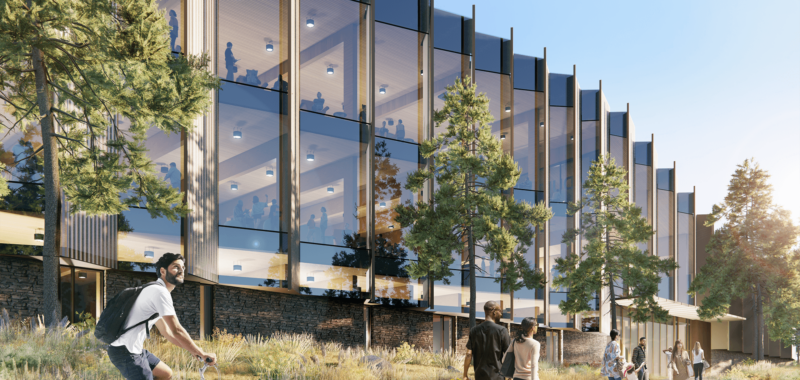Today, a library is so much more than a civic building for borrowing books. The city of Bend, Oregon, and architecture firm Miller Hull acknowledged this in the design for Deschutes County’s new central library, where patrons can peruse texts, per usual, while also viewing art and purchasing a hot cup of coffee.
The new library by Miller Hull, a practice with offices in Seattle and San Diego, will top out at 3 stories and be built at Stevens Ranch, a tract just east of downtown Bend. The building, Miller Hull shared, is “designed to speak to the young, old, studious and synergistic, the Stevens Ranch Library will have a space—and be a place—for everyone.”
Miller Hull has proposed an attractive accordion facade which regulates daylight and takes inspiration from central Oregon’s arid landscape; namely its brush and dust. The glass accordion component rests atop stone; the jagged roofline was conceived to recall nearby mountain ranges.

All in all, the 100,000-square-foot building is one of several new libraries underway in Deschutes County. Beyond the book stacks, the new civic building in Bend will house an art museum and retail. Coffee shops will be able to lease out commercial space not far from where young entrepreneurs can hit the grind at coworking desks, and artists express their creativity in studios.
Everything from air fryers, sewing machines, and fly-fishing kits will be available to library card holders. This “Library of Things” concept, Miller Hull shared, will enable visitors to “try things on” without owning or purchasing the object. It will also give residents the opportunity to pick up new hobbies, and sustain a lifelong journey of curiosity.

To reduce carbon impact, Miller Hull opted for mass timber construction. Acoustic dowel-laminated timber (ADLT) will perform as flooring, finish material, and acoustic system. ADLT be used in the floor deck system, which measures 8 feet wide by 40 feet long. This size was chosen to forgo the slab of concrete typically needed to prevent seismic racking of the columns that separate floors.
Renderings from Miller Hull of the building and its interiors center the mass timber component. A sculptural staircase on the ground level will be constructed primarily in wood—from steps to the banisters and balusters.
Construction on the new library will complete in 2026.

